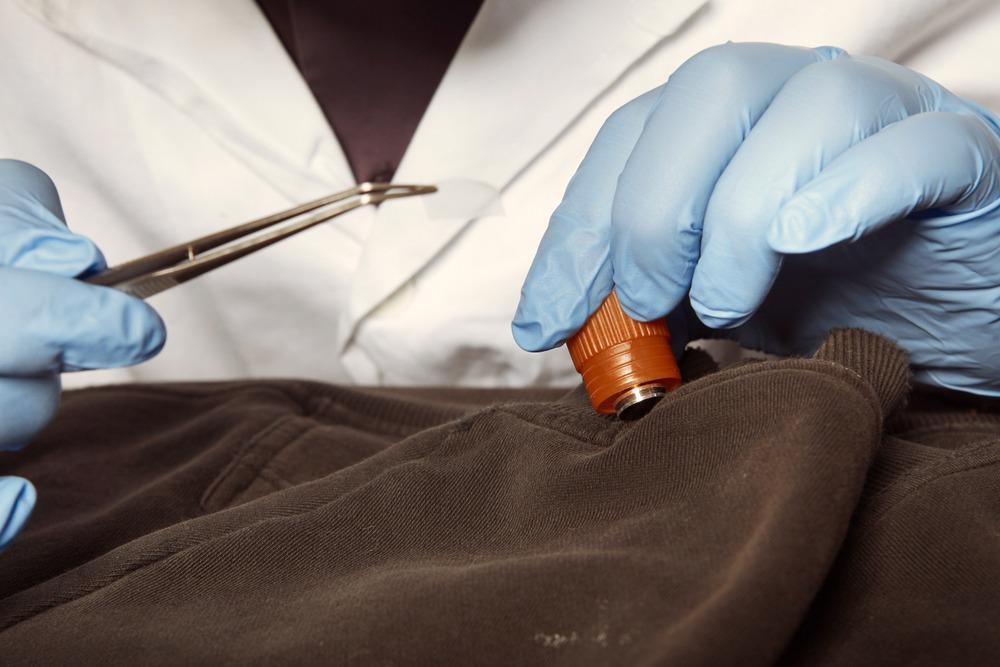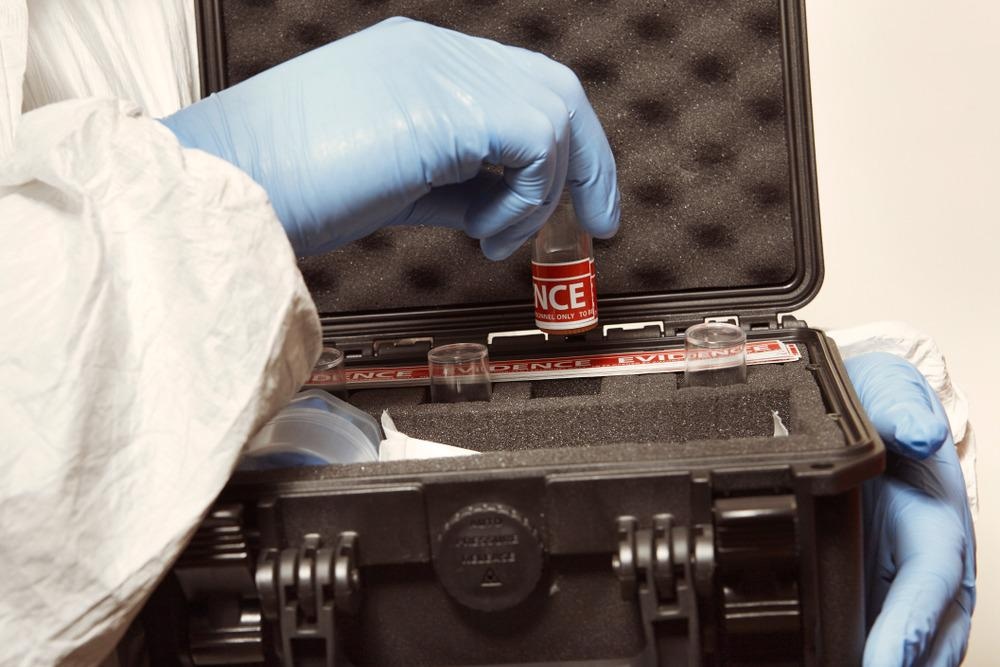Scanning electron microscopy (SEM) has been an important tool for forensic science since the 1970s, and it continues to find forensic applications today. The technique – capable of 100,000x magnification and higher – is widely employed to detect gunshot residue at crime scenes, while advances in SEM technology include environmental SEM (ESEM) and SEM with energy dispersive X-ray spectrometry (SEM-EDX) have enabled new inspection methods for advanced forensic science.

Image Credit: Couperfield/Shutterstock.com
How Does SEM Work?
SEM devices create images with high magnification and low resolution. By using a focused high-energy electron beam instead of light to magnify a sample, SEM breaks the diffraction limit of optical microscopy (set by the physical distance between waves of light, or light’s wavelength) and is used to study phenomena and matter at the nanoscale. Scanning electron microscopes (SEMs) can achieve magnification higher than 100,000x with a resolution below 1 nm.
An SEM uses an electron gun or cathode to emit a beam of electrons toward the sample. Electrons pass through the anode on their way out of the cathode and are focused into a strong beam. When this beam meets the sample, interactions between electrons and particles of matter in the sample material produce signals which are interpreted by computers to create a magnified image.
There are three main signals that occur when an SEM electron beam meets the sample. Secondary electrons, backscattered electrons, and X-rays are produced from interactions between electrons and the sample material, and each gives different information about the sample.

Image Credit: Couperfield/Shutterstock.com
Secondary electrons emanate from atoms on the surface of the sample material and recording them enables SEMs to output detailed, topographic imagery with high spatial resolution. Backscattered electrons are refracted incident electrons that have pierced below the sample surface and interacted with atoms inside the material. Atoms of more massive elements in the sample bounce incident electrons further away, and these scatter patterns can reveal information about the sample’s internal elemental makeup.
X-rays are formed when electrons in the electron beam replace electrons from atoms in the sample. When this happens energy must be released, and it is released in the form of X-rays. The wavelengths of X-rays produced in SEM are related to the elements that electrons have interacted with. Energy-dispersive spectrometry (EDX) is combined with SEM in SEM-EDX to record this information.
For SEM to work, samples need to either be conductive themselves or be coated with a conductive material such as gold-plated nanoparticles. Typically, SEM must also be carried out in a vacuum with dried sample material.
Since the 1970s, SEM has found numerous applications in forensic science. Forensic scientists use SEM to find forgeries, understand how textiles got damaged, and detect the presence of gunshot residue at crime scenes.
Some SEM Applications in Forensic Science
A major application for SEM in forensic science is the detection and analysis of gunshot residue. Gunshot residue or GSR is the name given to particulate matter that is emitted when metals in a gun are vaporized due to the immense heat and pressure applied to them. There are three main compounds used for gun cartridge primers, and therefore three main compounds that appear in gunshot residue: lead styphnate (Pb,) barium nitrate (Ba,) and antimony sulfide (Sb.)
Because the Pb, Ba, or Sb particles emitted by gunshots are so small, gunshot residue analysis only became possible with the advent of SEM in forensic science. Gunshot residue is often found on the clothing of somebody who has fired a gun, although finding gunshot residue is not enough on its own to identify a shooter. Finding gunshot residue can place people at crime scenes, although gunshot residue has been found as far as 13 m away from the gunshot.
SEM-EDX is applied in forensic science in order to help find and identify material that could be used as evidence. SEM-EDX is a useful tool because it allows forensic scientists to conduct multiple exploratory investigations on a sample simultaneously.
In SEM-EDX, a micrograph is first generated employing backscattered electrons. This provides morphological information about the sample’s surface at nanoscale resolution, as well as helps investigators identify gunshot residue particles of Pb, Ba, and Sb. The SEM process is typically automated in modern forensic science.
The SEM stores the location of gunshot residue on the sample, and then a trained analyst assesses each potential candidate for gunshot residue particles for positive identification. If the analyst is confident enough that gunshot residue has been detected, the particles’ EDX data is analyzed to exactly fingerprint their elemental composition.
ESEM is also increasingly used for forensic science. The technique enables SEM investigation to be carried out without the sample preparation requirements of conventional SEM, particularly the requirement to perform investigations in a vacuum. ESEM is better suited to investigating biological and other “wet” samples, and was recently used to identify phosphorus consumption as the cause of death in a “cold case.”
More from AZoM: Novel Applications of Polyvinyl Alcohol
References and Further Reading
AZO Materials (2010). Applications of Scanning Electron Microscopes in Forensic Investigations. Azom.com. [Online] Available at: https://www.azom.com/article.aspx?ArticleID=5528.
Taylor, M.E. (1973). Scanning Electron Microscopy in Forensic Science. Journal of the Forensic Science Society. Available at: https://www.sciencedirect.com/science/article/pii/S0015736873708252?via%3Dihub
Viel, G., G. Cecchetto, L.D. Fabbri, et al (2009). Forensic application of ESEM and XRF-EDS techniques to a fatal case of sodium phosphate enema intoxication. International Journal of Legal Medicine. Available at: https://link.springer.com/article/10.1007/s00414-009-0344-9
Zadora, G. and Z. Brożek-Mucha (2003). SEM–EDX—a useful tool for forensic examinations. Materials Chemistry and Physics. Available at: https://www.sciencedirect.com/science/article/pii/S025405840300018X?via%3Dihub
Disclaimer: The views expressed here are those of the author expressed in their private capacity and do not necessarily represent the views of AZoM.com Limited T/A AZoNetwork the owner and operator of this website. This disclaimer forms part of the Terms and conditions of use of this website.